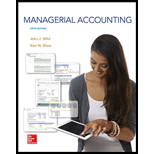
Managerial Accounting
5th Edition
ISBN: 9781259176494
Author: John J Wild, Ken Shaw Accounting Professor
Publisher: MCGRAW-HILL HIGHER EDUCATION
expand_more
expand_more
format_list_bulleted
Question
Chapter B, Problem 4QS
To determine
Present Value:
Present value of money means the present or current value of a future
Future Value:
The future value is the value of present cash flow at specified time period and at specified
We have to determine the amount to be invested.
Expert Solution & Answer
Want to see the full answer?
Check out a sample textbook solution
Students have asked these similar questions
The company has the following historical information based on similar trips taken overseas
A company reported an interest.
expense of $50 million and cash
paid for interest of $40 million.
What was the change in interest
payable for the period?
Given the solution and accounting question
Knowledge Booster
Learn more about
Need a deep-dive on the concept behind this application? Look no further. Learn more about this topic, accounting and related others by exploring similar questions and additional content below.Similar questions
- Please provide the accurate answer to this general accounting problem using valid techniques.arrow_forwardThe Soft Company has provided the following information after year-end adjustments: -Allowance for doubtful accounts was $11,000 at the beginning of the year and $30,000 at the end of the year. -Accounts written off as uncollectible totaled $20,000. What was the amount of Soft's bad debt expense for the year? A. $39,000 B. $1,000 C. $19,000 D. $20,000arrow_forwardGeneral accounting questionarrow_forward
- Answer? ? Financial accounting questionarrow_forwardBenz Corporation applies overhead costs to jobs based on direct labor costs. Job P, partially completed at year-end, shows charges of $4,250 for direct materials and $7,200 for direct labor. A previously completed Job Q had $12,500 in direct labor with $8,750 in overhead costs. a. Should any overhead cost be applied to Job P at year-end? b. How much overhead cost should be applied to Job P?arrow_forwardRock Industries made sales to two customers. Both sales were on credit terms of 3/15, n/45. Customer A purchased $50,000 of goods, returned none, and paid in 14 days. Customer B purchased $75,000 of goods, returned, and was given credit for $7,500 of goods and paid in 30 days. What was the net revenue from these two customers?arrow_forward
- A local bakery sells 12,000 loaves of sourdough bread each year. The loaves are ordered from an outside supplier, and it takes 4 days for each shipment of loaves to arrive. Ordering costs are estimated at $18 per order. Carrying costs are $6 per loaf per year. Assume that the bakery is open 300 days a year. What is the maximum inventory of loaves held in a given ordering cycle?arrow_forwardI am searching for the accurate solution to this financial accounting problem with the right approach.arrow_forwardOn April 30, 2014, Tilton Products purchased machinery for $88,000. The useful life of this machinery is estimated at 8 years, with an $8,000 residual value. Assume that in its financial statements, Tilton Products uses straight-line depreciation and rounds depreciation for fractional years to the nearest month. Determine the depreciation expense recognized on this machinery in 2014 and 2015.arrow_forward
arrow_back_ios
SEE MORE QUESTIONS
arrow_forward_ios
Recommended textbooks for you
 EBK CONTEMPORARY FINANCIAL MANAGEMENTFinanceISBN:9781337514835Author:MOYERPublisher:CENGAGE LEARNING - CONSIGNMENT
EBK CONTEMPORARY FINANCIAL MANAGEMENTFinanceISBN:9781337514835Author:MOYERPublisher:CENGAGE LEARNING - CONSIGNMENT

EBK CONTEMPORARY FINANCIAL MANAGEMENT
Finance
ISBN:9781337514835
Author:MOYER
Publisher:CENGAGE LEARNING - CONSIGNMENT
How To Calculate The Present Value of an Annuity; Author: The Organic Chemistry Tutor;https://www.youtube.com/watch?v=RU-osjAs6hE;License: Standard Youtube License